

|
Part II of "Being Seen by Rembrandt," copyright © 2001 by Gerald Owen Grow http://www.longleaf.net/ggrow/rembrandt |
|
I have argued that (among other things) Rembrandt's great self-portrait in the Frick Collection combines into one image several facial expressions that normally take place over time. It uses a left-right split to hide one of the expressions--the smile--in plain sight, hidden by being overshadowed by the other side of the face. The portrait also combines other expressions by interleaving them so that they share the same space, competing for attention with key areas (such as the corners of the mouth), spread out with a smudge that permits several interpretations. The smudge might cover the area the mouth would occupy in both a smile and an angry frown, for instance. The result is a portrait that is both definite and ambiguous. It is liminal: It borders several emotional expressions, and, depending on the light in which you look at it (both the outer and the inner light), the face subtly changes expression--the way living people do. This all sounds plausible, but how would we know if this interpretation is any more valid than another? -- There is one test we could perform: What if this analysis could be used to produce a convincing self-portrait? Please bear with me from this point forward: In order to carry out this test, I must ask you to shift from looking at Rembrandt to looking at pictures of the only person interested enough to carry out this experiment in portraiture, available on my schedule, and affordable -- me. As a way of testing the ideas behind this article, I took a series of hammed-up photos of my own face, in which I made the effort to express a series of different emotions inspired by the ones I was finding hidden in Rembrandt's own face. The expressions are pretty theatrical -- familiar representations of ease, happiness, anger, contempt, worry, sadness. Inspired by the tone of Rembrandt's portrait, I did not record many happy expressions for this experiment in portraiture. Faces with Split ExpressionsThe first experiment was with faces that contained different expressions on each of the two halves--thinking of how Hals and Van Dyck employed this method of portrature. I extracted the left halves of the photographed faces, then the right halves, and began to mix and match them. The results, though somewhat mechanical, were intriguing. |
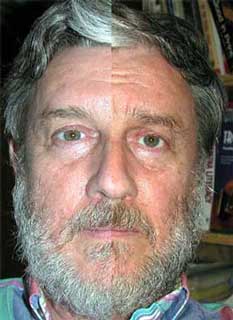 |
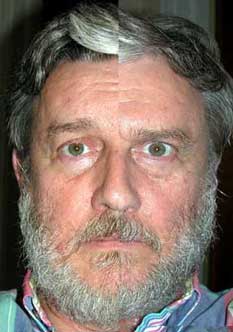 |
| My version of the Viennese expression: Cheerful but worried. | The other half of that worried face, plus angry. |
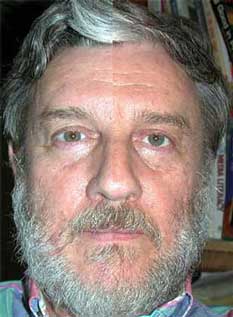 |
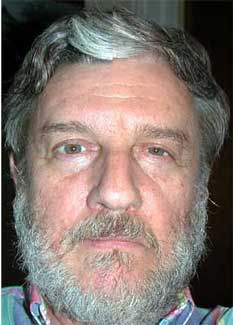 |
| An easy cheerfulness dominates this face, but if you block off the cheerful left side, you will see a fallen face. | The cheerfulness here is clearly qualified by a contradictory expression, but can you see what it is? If you block off the cheerful left side, you will see a different face. |
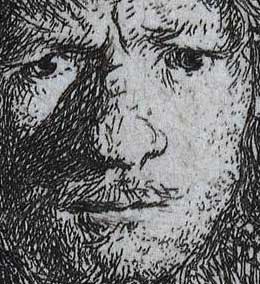 |
When you look at the "angry" face up close, its contradictory expressions become clearer. Beneath the angry pose is a face of vulnerability, self-doubt, worry, a hint of disgust, a sense of loss, perhaps a struggle against helplessness, an overall tenderness, a great strength of determination, a surge of personal power, and a whiff of guilt (or the equivalent of this reading in a differently perceived mix of emotions, depending on who is looking.) This face has more than a left-right split, for the eye on the left has a heavy drooping lid that weighs down the energy of the anger moves it toward the defiant, hurt look of someone preemptively protecting the rawness of his emotions. The unresolved contradictions in the expression draw in the viewer, engaging us in interpreting the etching-- and in seeing ourselves. In creating works that had the ability to grab viewers, pull them in, and engage them in interpretation and discussing their interpretation, Rembrandt was not only exploring his humanity, he was also creating marketable products that had a powerful and mysterious appeal. Recent research has emphasized Rembrandt's production of such "tronies" -- portraits of interesting heads, often in costume and emotionally primed to visually represent standard concepts in the culture: "piety, bellicosity, the strange and exotic, youth, old age, transience, and so on" (van de Wetering, 21). I suggest that Rembrandt, in his tronie-like self-portraits, went far beyond cultural icons to present images that gained added power by containing undercurrents that challenge their dominant emotion. These were icons that reflected the sense of complexity that accompanies self-awareness. |
Faces with Interleaved Expressions
|
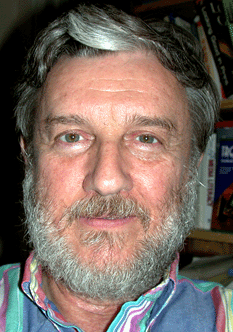 |
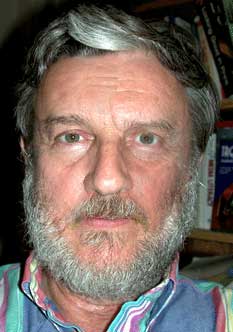 |
| Original photo--animated to add each change. (You may have to wait for the animation to load.) | Completed portrait combining parts of five photos and three Rembrandt "smudge" effects. |
| The original picture was altered in this way, in this order: |
Starting with a cheerfully neutral photo, I added expressive portions from the other photos (plus three ambiguously expressive elements from Rembrandt's self-portrait):
- the smudge from the left corner of Rembrandt's mouth, which makes the mouth less definite
- a fallen left cheek from a sad expression
- the right eye and brow crease from an angry expression--with the highlight of the eye diminished
- the fallen right cheek from a despondent look
- the smudge from the right corner of Rembrandt's mouth, which makes the rest of the mouth indefinite
- the left brow from a worried look
- a partially transparent overlay of the right eye from the worried look, which qualifies the angry eye without displacing it
- the under-eye wrinkles from the right eye of a smile, which qualify both the sad and angry parts of the face
- the falling triangle from Rembrandt's left cheek, blended in, which qualifies the smile wrinkles
|
In the animation, you can watch the original cheerful expression being modified by each of the elements above. To stop the animation on any image, hold down your mouse.
|
| To complete the portrait, I darkened the picture to increase the chiaroscuro effect and added golden highlights. As with Rembrandt's self-portrait, the increased darkness seems to bring out the complexity of the face. |
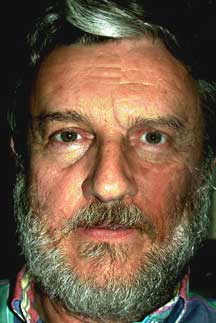 |
I sometimes think of William Blake's aphorism when I work with graphics: "You never know what is enough unless you know what is more than enough." So the first version takes everything too far--it is dramatic, conflicted, heightened -- Rembrandtesque. The second version contains the same elements in a more subtle, modulated form -- but it is all still there. The first face is torn by its contradictions; the second seems, if not to integrate them, at least to gather and hold the contradictions in one personality -- something I aspire to -- and something I turn to Rembrandt for help with. Influenced by the tragic dignity of Rembrandt, this portrait has modified a cheerfully confident face to suggest a shadow side of subtly turbulent yet familiarly human cross-currents. Does it look like me? -- No, but in some ways it looks more like me than I look like myself. |
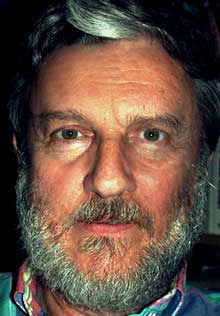 |
| Gerald's self-portrait based on Rembrandt's method of interleaving contradictory emotions -- First Version, with the contradictory emotions highlighted and a distinct left-right split. | Gerald's self-portrait based on Rembrandt's methods, Second Version, with the same contradictory emotions, but more subtly combined. |
 |
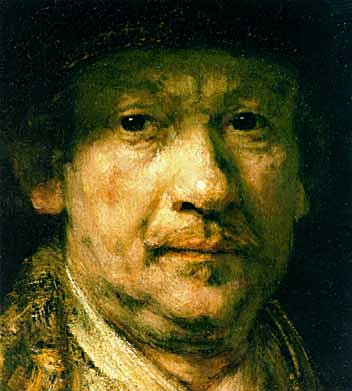 |
|
The right eye presents an almost startling puzzle. As your eye searches the nearby cheek and brow for clues, the eye shimmers among borderline expressions that suggest intense interest and suspicion and accusation and anger and contempt and hurt and exhaustion and sorrow and worry and puzzlement -- take these labels only as pointers -- all with an inexplicable underlay of gladness, acceptance, and delight. (Some of these are more evident in the first version of the portrait, where the right eye is like a little black hole sucking you into the portrait.) But the right half of the face refuses to resolve into a single reading. And we know why: The animation above shows that it is composed of several interleaved expressions that contradict and qualify one another without any one of them becoming dominant. The face has been composed using Rembrandt's method of interleaving competing expressions -- only I have used photo-editing techniques, and not his painterly smudges, to create the multiplicity.
Conclusion. We know what expressions are in this face -- we don't have to guess -- because we have put them there by cutting and pasting them from photographs that clearly contain those expressions. What is amazing is how readily these contradictory expressions blend together into something that begins to look like a real face seen in real time -- and yet it retains a greater range and sense of liminality -- of being poised on the threshhold of several possibilities -- than any one of the photos it was made from. What do you think? Have we learned anything from this study of a Rembrandt self-portrait? Do these changes transform the original, blandly-cheerful photograph into an engaging portrait? Does it have a sense of complexity about it that makes it seem more human? Does it seem to change as you look at it? Do you feel seen by it? Does it seem alive? Do the mutually contradictory expressions in the portrait draw you into actively engaging with it? Do you not just look at it, but also interact with it? Have these observations about Rembrandt's method enabled me to produce a portrait that looks back at you and seems to comment on what it is like to be human? We can think of this as an exercise to test a theory about Rembrandt's method of portraiture. Or we can think of it as an effort to imagine what it might be like to be seen by Rembrandt.
|
|
After producing a self-portrait modeled after the tragic dignity of Rembrandt's own, I found myself uncomfortable around it. In response, other, less-serious self-portraits have emerged that feel like an attempt to balance the deep seriousness of Rembrandt with the more fortunate and cheerful core of my own nature. Part III: After Being Seen by Rembrandt.
|
Copyright © 2001 by Gerald Grow
Back
to "Being Seen by Rembrandt" at <http://www.longleaf.net/ggrow/rembrandt>
